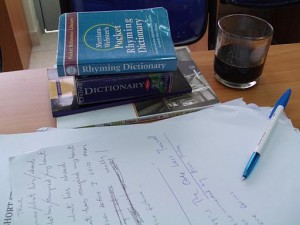Don’t lose your inspiration
You know the situation: You feel inspired, you have this great idea and you just want to write it down. So you start typing, the words and sentences sort of magically appear in your mind, and suddenly … damned, was it “beautiful” or “beautyful”?
You keep typing both to see if the looks remind you of the correct version, choose beautiful and continue to … think … about … what … you … were … writing … And that’s it. You just lost it.

If you are in a flow and your thoughts stream and just make you type this fantastic article, stopping to correct misspellings can throw you out of mood in seconds. And that can really make you angry.
But, why this instinct to stop and correct when you are so inspired? Why risk to lose your concentration over a few misspellings? Is it not by far more important to get to say what you have in mind and communicate your thoughts than to bother about an “i” or a “y”? Yes, it is.
So, here is our tip of the day:
Separate the creative writing and the more rational proofreading processes.
Don’t bother about little details until you have finished the big picture. Start writing your articles, stories or whatever you need to define into written text and only after your stream of thoughts and arguments has come to an end step back and take a look.
Leave the proofreading moments for uninspired times where you can grab a cup of coffee, run the spellchecker and correct all the spelling errors you get. Then take a look again and start reading it with a rational mind to see if what you wrote really makes some sense. You don’t need to be inspired to do so. With services like Online Spellcheck it is quite easy to go over a text and decide calmly about any changes.
So, resuming, follow these steps:
1. Write
Start typing what you have in your mind. Avoid the “blank page” syndrome many writers get by just typing what crosses your mind. You will start thinking in no time and all sentences and logical thoughts will be written down in one stream of consciousness. Don’t interrupt yourself with minor things when you are inspired.
2. Check the misspellings and typos
Finished with your inspirational and creative moment? Then it’s time to step back and start editing. You got the spirit, now you have to get it into a readable form. Start with a simple spelling check. Copy and paste your text into the online spellchecker and take a look at the corrections. Start working them through until you have finished. This can be hard work and you may need to stop to look for vocabulary at any moment. But this is just a concentrated work process where the creative part of your mind can rest.
3. Proofread for grammar
Do the same thing for grammar errors. S0metimes grammar errors are just typos, sometimes they show a lack of logic in a sentence. Just go over all errors methodically and you may refresh your grammar skills at the same time as you correct your text.
4. Proofread for logic
Once your text has passed the spelling and grammar checks, read it with a rational mind. Are there any logical gaps in the text? Do all sentences base on their predecessors for a good understanding? Are the main ideas easy to understand without prior knowledge?
If you can answer all this with a big, fat YES, it’s done!
